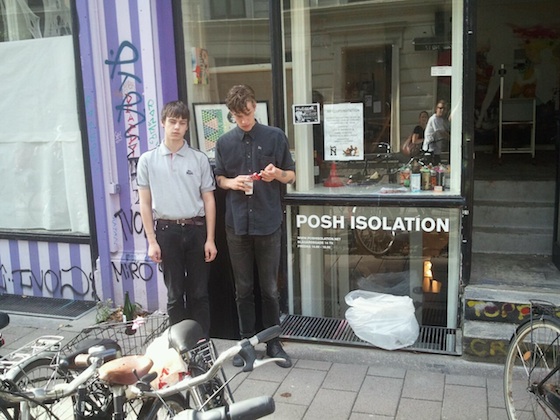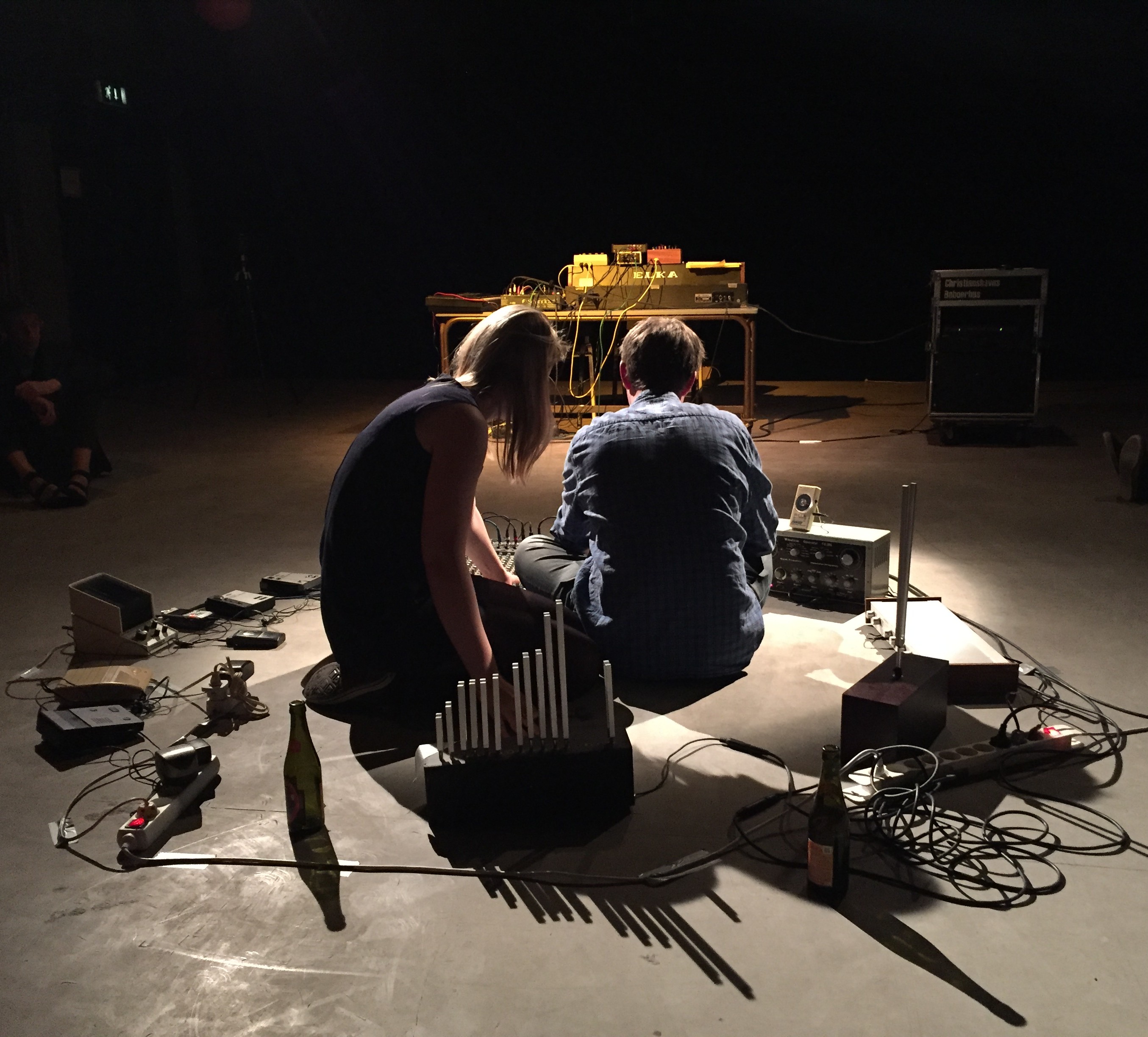MadeiraDiG 2018 – Notes on island mentality
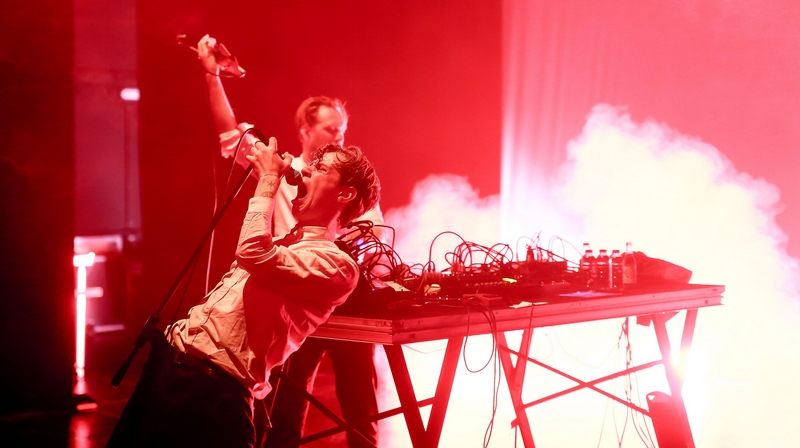
Live report by Mette Slot Johnsen
I grew up on a small island in Denmark, and I live on a big one in London, UK. I’ve never thought of island mentality a lot beyond instinctively wanting to escape it, but with Brexit looming I wanted to revisit island mentality and what it means. When I came across MadeiraDiG, an avantgarde music festival taking place in December on Madeira, it seemed like a perfect place to go explore and reflect on the term.
When I began writing this I was gazing at the Atlantic Ocean, a small lizard nibbling my toes. It didn’t feel quite real then. It still doesn’t.
As the plane approaches Madeira, I try to get a peek of the island through a mass of clouds, but I only get brief glances of bright green hill sides and volcanic rock beaches. The plane initially can’t land due to the weather, so we circle around again for another 15 minutes before making a 2nd attempt. On the ground the rain is pouring, and the sea and clouds blend into a monotone grey.
We traverse the island through a myriad of tunnels and bridges, furthering the sense of time being warped as we move around the island in the minibus, coming out of a long tunnel into new micro climates and sudden blistering sun and reflecting ocean. On the hill sides farms grow vegetables on terraced land; banana palms, cacti, succulents and loud tropical flowers are everywhere. Brightly coloured colonial style houses with red terracotta roofs mix with 70s institutional architecture, folk-art mosaics and murals, and modern infrastructure projects in glass and concrete.
Madeira is both distinctly tropical and at the same time overwhelmingly European. It’s at once both isolated and geographically forbidding while insanely inviting and very welcoming. According to the locals I ask island mentality is firmly in place, despite the hospitality. However, here asking yourself why you would ever leave the island doesn’t equate underestimating your connection to the rest of the world.
Cue MadeiraDiG: A festival which is like an elaborate family get-together; the extended alternative music scene from Berlin on tropical winter holiday.
With everyone arrived in Ponta Do Sol which will be the host to the festival guests for the next 5 days, the festival starts with welcome drinks watching the sun set over the Atlantic, to the backdrop of industrial club music. It’s a bit like going to a good house party where you know only one person, otherwise all new faces but an immediate sense of being welcome. There’s an easy familiarity between the regulars which encapsulates newcomers, as artists and audience mingle over the evening and the rest of the festival.
The early concerts take place in MUDAS, the museum of contemporary art, between 9pm and midnight, and the late ones from 1am-4am in a covered courtyard at the James Bond’esque host hotel Estalagem Ponta Do Sol. After the sun has set, we gather to go to the first concert. On pitch black lowly lit roads, we wind our way in a coach from the village to the museum. At first the building seems invisible, leaving everyone to wander in the darkness towards a cliff edge. Like looking for an illegal rave, in an art museum. That sensation is apt as an opening act to the music.
MUDAS is sprawling: Pouring down the cliff side its grey external blends in with the surroundings, while inside it’s airy white and elegant. The music venue is tall, with blood red seats and black wood panels, slashed through with neon light seeping out from the gaps and the edges. It’s three layers of architectural drama, a perfect match for an Argento film. Each part is imposing in their own way, adding a sense of formality to the performances and encouraging deep listening in the audience. The stage is cavernous but bare, there is no hiding here. It’s a far cry from underground venues and experimental music salons, and at times the musicians look a little uneasy with the formality. So light and smoke is used to manipulate the sense of space and soften the undistracted focus from the static audience.
The first night opens with island locals Rui P Andrades and Aires. Surrounded by luscious greenery there are sounds of rainforests, heart beats, mixed with deep drone and thundering bass. The music is meditative and introspective, the recent album is a break up album and it feels like the sounds from a mind where the thoughts aren’t quite allowed to be thought through. Instead when they’ve become comfortable, they’re interrupted by something else. There’s a sense of positive reflection in the music, the sounds from the island’s forests and the sea evoking calm and highlighting a connection with the environment.
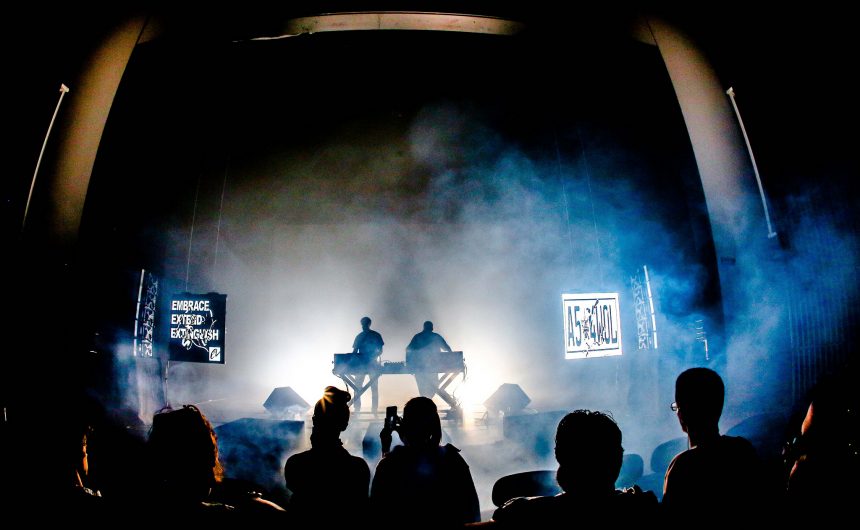
Amnesia Scanner – photo by Roland Owsnitzki
After the introspective start Amnesia Scanner from Finland set out to invade minds rather than inviting audiences into theirs. A demonic cartoon figure – the Oracle – is projected onto a balloon, its features blur and its synthetic voice is distorted. Light boxes and LED screens start firing strobes into the room mixing with thick smoke, I’m like deer in the head lights. Everyone sits nailed to the seats while bombarded with occult tinged, dark web memes, anarchic messages and words that nearly make sense but don’t quite. Despite bordering on the gimmicky it’s genuinely disturbing. Trap, electro cumbia and industrial sounds mix with uneven noise terror. It’s mind bending and irresistible. With retinas burnt to a crisp the audience walk out wounded. Some love it and some hate it, but it seems no-one’s ever seen anything like it. It sparks a lot of conversations over the rest of the festival.
After an incredible breakfast I join a trip to the northside. Crossing the island in a full coach, we drive in hairpin turns with steep hill side drops and nearly get stuck in a tunnel. There’s the excited atmosphere of a school excursion. We go on a stunning trek along the coast from the village Arco Do Sao Jorge, it’s nothing short of otherworldly. Walking means talking, and the festival locals answer questions about island life. Some cons being a lack of subcultures and opportunities, and firm pro’s the nature and the community. Travelling between the island and the mainland is easy, so why chose the capital when you can go there for a visit and come home to the wholesome luxuries of the island?
We end with a big communal lunch in the afternoon sun. Welcomed with cold drinks, in true sun starved tourist style the meal is moved outside. We eat overlooking the scenery and discussing European politics, cultural idiosyncrasies and the festival. There is no sense that anyone’s censoring conversation or assimilating opinions. What would be the point of being here if we can’t speak freely?
That night Polish Resina has a spartan set up of cello and electronics, with a large projection behind her, slowly revealing an ancient cracked masque. Merging into primitive looking cartoons similar to cave paintings, they depict scenes of hunting, conflict, decay and destruction. It gives a sense of history repeating itself. With her cello chamber music Resina mixes mournful and at times abrupt cello sounds with electronics, using loops or clicks and found sound. The set builds up to two final tracks featuring primarily her voice, with wordless vocals she sonically accompanies the projections behind her, displaying fake news, emoticons and genetic manipulation following the theme of beautiful and captivating dystopia. It’s uneasy and thought provoking.
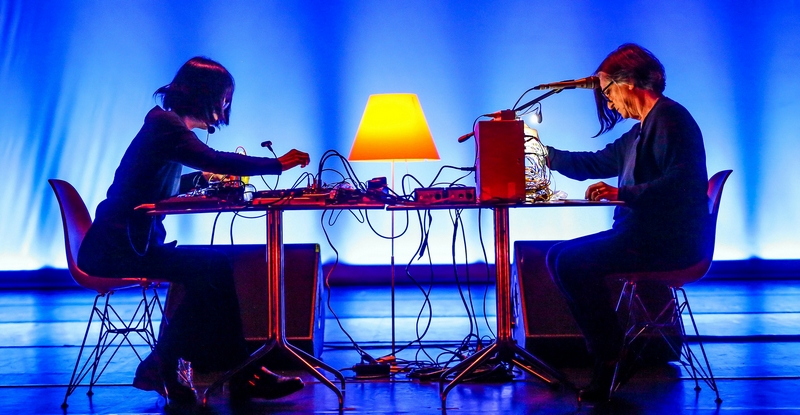
Phew and Ana Da Silva – photo by Roland Owsnitzki
Ana Da Silva and Phew, arguably the festival’s headlining act, continue the night. Despite early backgrounds in punk bands they’ve both been exploring electronic composition for a long time, and this night they’re performing music from their album “Island”. Primarily on modular synths, which they play facing one other at a large desk. It’s measured minimalist music, songs building up slowly and incorporating sounds and vocals sounding like bits of conversations attempted and somewhat disrupted across long wave radios. Phew mutters and shouts, using heavy feedback to push the levels into unexpected reds when we become too comfortable. The two musicians swap languages calling out familiar phrases, it sounds warm and carefully optimistic about reaching out beyond the shores of their islands.
We come back to the hotel to find a midnight feast waiting. Everyone partakes in eating and drinking while discussing the music and the day’s activities, and regaining strength for the last hours of music in the tent hotel stage. That night the louche Romanians Karpov Not Kasporov bowl everyone over with 70s disco mixed with eastern European sounds and, initially questionable, performance art vibes. They’re brilliant and totally original.
As the late nights start to take their toll Sunday is largely spent collectively lounging and exploring the island. By now pretty much everyone is a familiar face, including the village bar owners and the stray dogs who lounge on the warm pavement. Drifting around the village various levels of hangovers are treated with salty sea food or a bout of ubiquitous yoga on the hotel terrace.
With a political backdrop of Brexit and border closings, chosen isolation and proverbial island mentality seems to be a key international tendency these days. I sit down with Ana Da Silva and Phew to talk about islands. The ones we’re from; the ones we live on; the one which is their album, and the one we’re visiting. Both artists are islanders, by birth and by choice, Da Silva in the UK and Phew in Japan.
They both found their musical feet in punk and experimental DIY scenes and remain part of them, with Da Silva in the Raincoats and Phew as a prolific solo artist. 40 years after unknowingly sharing punk experiences in London, they’ve made the album “Island” across the airwaves and are now performing it on Da Silva’s childhood island.
The two agree that sometimes island mentality is valuable, being part of a small community can be beneficial. Phew adds that when frustrated one only needs to look to the night sky for a reminder that the universe is much bigger than the island you’re on.
Da Silva chimes in: We’re all islands anyway, all inherently alone. Our arms only stretch so far, but physical isolation doesn’t have to be isolating. Cities are their own islands, cultural and religious groups too. I agree, to me what’s truly isolating is lack of peers, personal connections, inspirational figures and community. Not bodies of water.
Da Silva reflects on Madeira: The island is geographically isolated but closely and easily connected to the rest of the world, so it doesn’t feel as remote. Events like MadeiraDiG helps open up the island to the world, inviting subcultures in and broadening horizons internally while attracting a new kind of tourists. In Da Silva’s youth there was only one town on the island, the capital Funchal, and the treacherous mountain roads made small villages like Ponta Do Sol very isolated. Now there are tunnels everywhere, making the villages and various corners of the island much better connected. But while it eases transportation around the island, the tunnels also deprive you of the scenery and a bigger sense of the island landscape. The destination has very much won the battle over the journey.
This can be said for the hyper connected world; ambling discoveries and hidden gems end up a fetishized luxury when everything’s otherwise expected to be instantly available. On one hand it makes an audience clued up enough to come to a tropical island for a niche music festival, and on the other it means them rarely being fully present. For DIY musicians like Phew and Da Silva connectivity opens up the world without having to engage with traditional music industry, allowing cooperation and influences to flow freely around the planet. It’s also overwhelming, with so much cultural output there is a need to shout louder to be heard and so Da Silva and Phew are both active but somewhat reluctant social media users while self-releasing on their album specific label Shouting Out Loud.
That night at MUDAS Eric Chenaux is on a bare stage, a warm golden spotlight illuminates him and his minimal set up of guitar, pedals and mic. The Canadian has a calm stage presence, his performance is in many ways much more organic and much less testing or confrontational than the rest of the programme. The songs are both lyrically and musically deceptively light handed and -hearted. But listen closely and it’s both complex, clever and amusing. There’s something particularly intimate about the way his Nick Drake’esque voice resonates beautifully in the space and there is a suitable 3rd day low key feel to it which is apt at this point, it’s comforting.
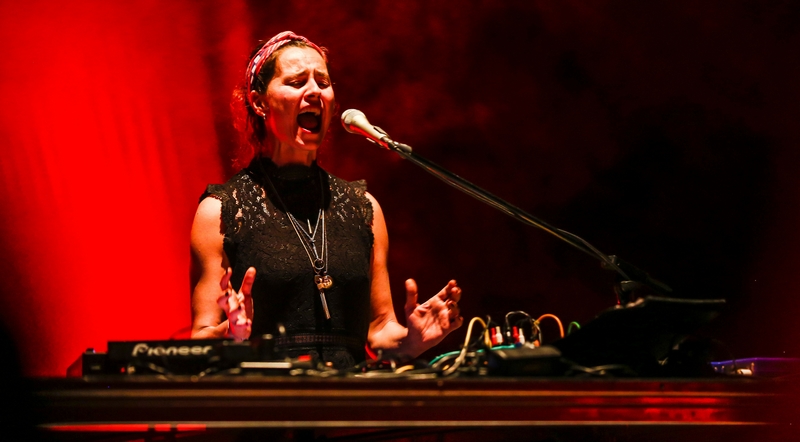
Maja Osolnik – photo by Roland Owsnitzki
Any ideas of a night of non-disruptive music is quickly blown to pieces as Slovenian Maja Osojnik takes to the stage next. Bathed in firelike light, she manoeuvres her technology and vocals like a warrior. Heavy beats prop up her deep dramatic voice as she takes protest songs to another level. I’m amazed. In voice not dissimilar to Barbara Morgenstern or Monotekktoni and lyrically on page with Jomi Massage, her performance is intense and once again everyone leaves the auditorium ripped out of the calm we were lulled into at the start of the evening. She delivers a lasting shake-up which I’d not seen coming.
We go back to the hotel for more fantastic midnight feasts and US cabaret crooner Baby Dee who with her harmonium and Weimar style songs mix tall NYC tales and queer witticisms with aching melancholy. She is charming and charismatic, with a presence felt throughout the whole festival. That night there is a buzz of socialising far into the night, but no walking dead to be seen the next day. Strong coffee will go a long way to counteract the rum.
On Monday a few of us who miss the main bus are corralled into a taxi and taken into the capital Funchal. The taxi driver is returnee local, who lived in London for years. He lovingly satirises the island saying there are two ism’s which rule: Catholicism and alcoholism, if you subscribe to one or the other you’re ok. And incidentally they go well together too!
The city is dressed up for Xmas in a wild way. As we saunter along the harbour front with its enormous cruise ships, the palm trees sway in the wind and boy choirs sing traditional English Christmas hymns from omnipresent amplifiers. A Brit, a Japanese, a German and a Dane present we do a little sightseeing but mainly drink wine and coffee, roasting European politics and how best to cheat on public transport. A universal theme if ever there was one. I wander the market, admiring the fish. The waters around Madeira are some of the deepest in the world, so some of the fish look prehistorical. I let myself get lost in classic colonial architecture and garish Christmas decorations, well kempt parks and steep alleyways.
Jessica Moss opens the last night with two traditional classical Jewish violin pieces, introducing them as she lays out her set, and verbalising the sense of community and otherworldly experience of the festival. After the first intricate and beautifully played pieces, she explains a little bit about “Entanglements”. The album is named after the phenomenon quantum entanglement; using this as a larger metaphor for universal interconnectivity the performance takes a holistic turn, and the music a more experimental one. She uses loops and layers both voice and violin, building the pieces gradually over 20 minutes ending in a lone vocal track fed back to sound like it’s made to move beyond the spheres. For me this is where she really comes into character, as her performance quietly urges collective responsibility for our surroundings and future generations.
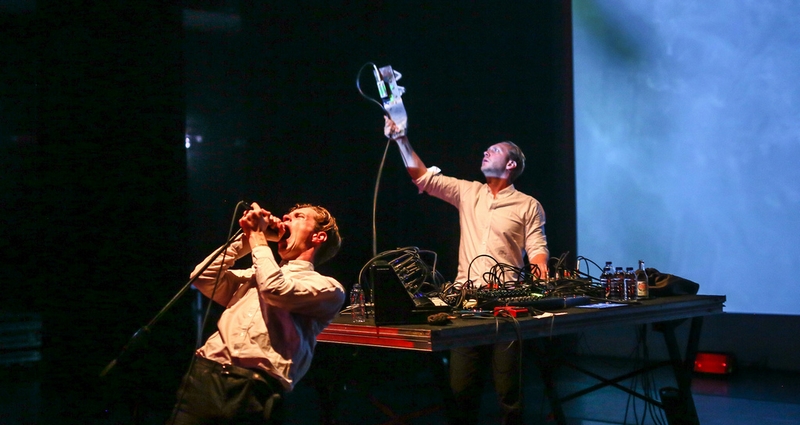
Damien Dubrovnik – photo by Roland Owsnitzki
Danish Damien Dubrovnik are the last artists to perform at MUDAS, closing this part of the festival with an anguished antidote to the calm reflection served by Jessica Moss. Christian Stadsgaard and Loke Rahbek take positions and start their noise assault, backed by imagery reminiscent of early Von Trier films or Lynch experimentation like “Inland Empire”. The music is somewhere between industrially charged noise and ambient soundscapes with Loke Rahbek’s abrupt departures into possessed shouting from the front of the stage. It’s intense and divisive, but is an intended last provocation – as visual as it is sonic – before the rest of the programme allows for dancing into the sunrise.
The next day I have coffee with the festival programmer, Michael Rosen. Curating his 10th year (together with a partner from Madeira), to him the festival is a continuation of the concept behind his Kiezsalon in Berlin. He curates intimate concerts bringing together clashing musical acts and audiences in a space to socialise without sensory overload. When he joined the festival, it was primarily noise music orientated, but being less focused on genre and more on a shared sense of cultural curiosity Rosen set out to curate the audience as much as the music. At 200 capacity per venue, the wrong audience can quickly affect the desired vibe of curiousity, inclusivity and open dialogue. This festival relies on an openminded audience who will go for the community and be surprised and engaged by the music.
This has resulted in the festival feeling a little like a much smaller, much more elaborate version of the legendary All Tomorrow’s Party festivals. The village and the local community are incredibly welcoming but typically fairly disengaged from the festival, apart from the local crew. It’s very much a labour of love for all involved not least the team at Estalagem, which provides the surreal and serene home base to most of the festival.
I spend the last day walking up the hill behind the hotel, up to the church next to the bright pink school. I walk one of the famous levadas (small irrigation channel) which winds itself into the island away from the coast, high on the hillside. I can hear the water trickling next to me in the levada, the river rushing at the bottom of the valley, and in the far distance the sea. It’s endlessly green and I’m alone with the sounds and the odd farm animal. Every time I decide I’ll stop and turn around I keep going a little longer. The isolation and the scenery are seductive.
In the evening a group of us have dinner on the sea front, and I’m warned about the post MadeiraDiG blues: The unbearableness of everyday when we leave this bubble again (it’s real and palpable). I find Rosen having a late night impromptu debrief with regulars and friends over drinks. We talk: His motivation is simply to affect positive change in people’s lives, now it’s played out in front of him: Here are hackers and squatters and bookers and artists and journalists etc, in a lively debate about the festival and everything outside of it. Providing further food for thought and serving as a final reminder of how to go looking for new communities when it’s time to leave the confines of an island which is turning in on itself.
MadeiraDiG opens up a connection between island life and city life, traditional culture and the avantgarde. Neither artists nor audience leave the festival or the island untouched by that.

